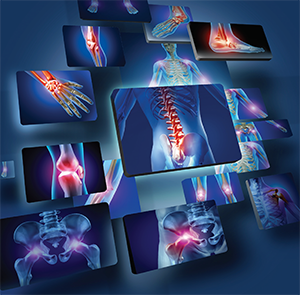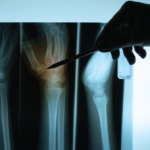
No single specialty focuses on bone health, and yet bone health in general, and osteoporosis in particular, are among the most common reasons patients are seen in rheumatology practices.
Lightspring/shutterstock.com
Bone health in general, and osteoporosis in particular, is among the most common conditions seen in rheumatology practices. The ACR recently joined the National Bone Health Alliance (NBHA) to reach out to other stakeholders.
“In 2004, the Surgeon General of the United States published a report on osteoporosis that discussed in depth the gaps in knowledge exhibited by both healthcare providers and patients,” says David Lee, MPA, executive director of NBHA in Arlington, Va. “It also talked about the need to establish a widespread coalition to bring all of the interested parties together. The NBHA was launched in late 2010 as a public–private partnership geared toward addressing these concerns.”
The NBHA comprises 50 nonprofit and corporate members. These include other medical specialty organizations, major pharmaceutical companies with an interest in bone disease, and representatives of various patient advocacy groups. There are also liaisons from five governmental agencies, including the Food and Drug Administration, the National Institutes of Health, the Centers for Disease Control and Prevention, the National Aeronautics and Space Administration, and the Centers for Medicare and Medicaid Services.
Rheumatologists in the Bone Health World

Mr. Lee
Rheumatologists are front and center in the bone health world,” says Kenneth G. Saag, MD, Jane Knight Lowe Professor of Medicine and Epidemiology at the University of Alabama at Birmingham, the first rheumatologist to serve as president of the National Osteoporosis Foundation and as co-chair of the Alliance’s steering committee. “The vast majority of this specialty has some engagement in osteoporosis and other bone diseases. The NBHA is a forum for groups to get together and talk about advocacy, education and programming.”
One of the major problems the Alliance is trying to address is that there is really no single specialty where bone health is all they do. This spreading out of responsibility can often mean a lack of continuity in research, education and treatment.
“Endocrinology, orthopedics, geriatrics and even family medicine physicians all have a hand in treatment of this disease,” notes Mr. Lee.
Focus on 3 Major Areas
The NBHA is currently focusing on three major topics of interest to the field. The national awareness campaign, 2Million2Many, highlights the 2 million bone breaks that occur in the U.S. every year due to osteoporosis. Created in 2012, the campaign raises public awareness of the connection between bone breaks and osteoporosis. It is based on a call to action for consumers and healthcare professionals alike: “If it’s 50+fracture, request a test.”
“Right now we have about a 70% care gap in terms of folks that have fractures,” says Mr. Lee. “Only about 30% are getting screened for bone disease and treated when appropriate. We know that without intervention, many of these will have bones broken over and over. This should help us connect the dots in the community between bone breaks and the potential for osteoporotic disease.”
Research on Prevention & Clinical Questions
Another undertaking is the Secondary Fracture Prevention Initiative. It is part of NBHA’s 20/20 vision to reduce bone breaks 20% by the year 2020. To meet this goal, the Alliance is pursuing widespread implementation of a Fracture Liaison Service (FLS) post-fracture care coordination model in a number of healthcare settings, including Medicare, managed care, large hospitals systems and private payers.
Research is also being undertaken. The Bone Turnover Marker Standardization Initiative notes that bone turnover markers (BTMs) have been recognized as useful tools in clinical practice. However, short‐ and long‐term fluctuations related to biology and technical variability have limited their clinical use to date.
This is an attempt to build on the recommendations of the International Osteoporosis Foundation (IOF)/International Federation of Clinical Chemistry and Laboratory Medicine (IFCC) Bone Marker Standards Working Group position paper published in 2010 in Osteoporosis International. This looked at the use and utility of bone turnover markers in clinical practice.
Groups are working on projects to determine the reproducibility of current markers, to establish population normal reference ranges for biomarkers across different machines and laboratories, and the Patient Sample Collection Procedure Standardization Project that seeks to derive a standardized sample handling procedure, from careful examination of existing data, as the foundation for all BTM measurements.

Dr. Saag
In the area of treatment, the NBHA is working on research into medication administration. The Drug Holiday Study is looking into the use of biomarkers to help clinicians determine how best to place their patients on a drug holiday. It seeks to determine the utility of using biochemical markers to establish the effect a drug holiday has on bone turnover for patients on continuous bisphosphonate therapy for five years or more.
They hope to expand on a publication from the FDA that suggested, for many individuals, a holiday from bisphosphonates might be considered after four or five years of continuous use. However, in that publication there was little guidance on how clinicians should proceed. This research may help give clinicians more actionable information on this subject.
Although osteoporosis is probably the bone disease that is most often seen by rheumatologists, it is not the only one that the group has on its agenda. For example, the Rare Bone Disease Working Group is facilitating the implementation of collaborative projects to advance the understanding of skeletal biology and encourage the development of new therapies to improve outcomes for individuals with less common bone disease.
Particularly Tenuous Times
Dr. Saag thinks the ACR teaming up with the NBHA is a way to work together nationally at a particularly tenuous time in the bone field. He notes that there has been a halving in the use of prescription therapies following a fracture. This has been coupled with a decline in reimbursement rates for dual-energy X-ray absorptiometry testing and a decrease in testing overall.
“ACR as a specialty organization for rheumatologists is doing a lot on its own,” says Dr. Saag. “But there is an opportunity to do a lot more by working with groups that bring together different specialties and different interests. There is power in numbers and working across disciplines can be crucial in achieving mutual goals.”
Kurt Ullman is a writer based in Indiana.

